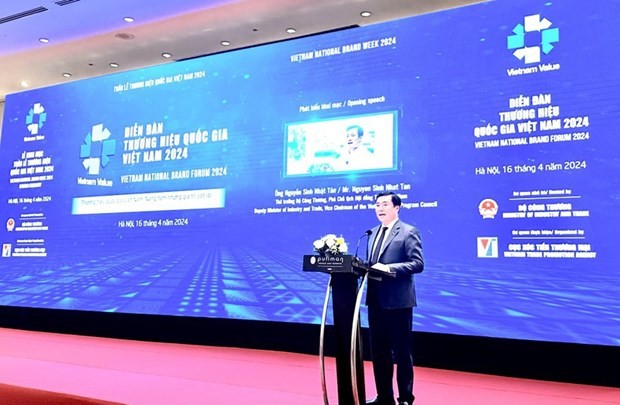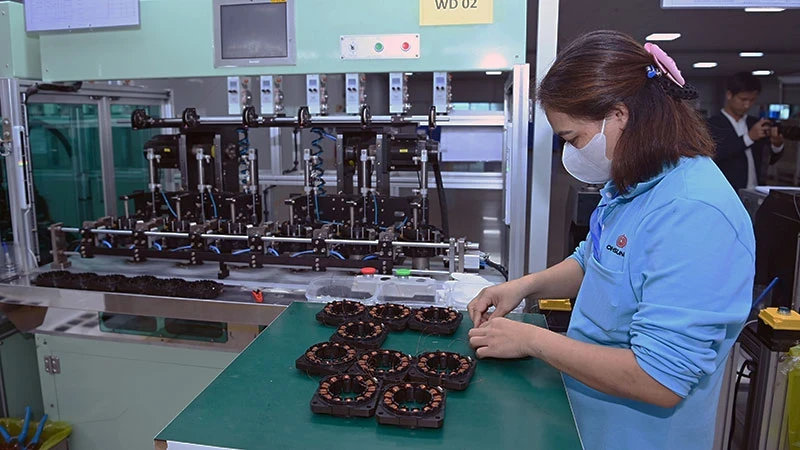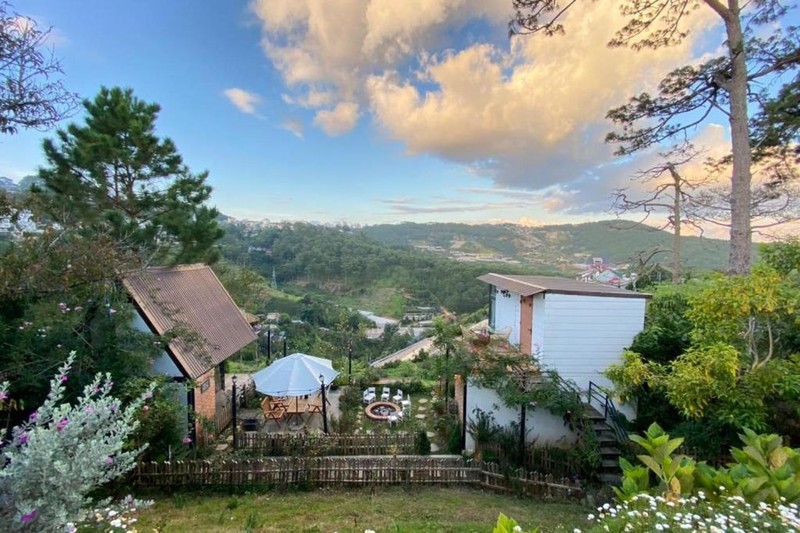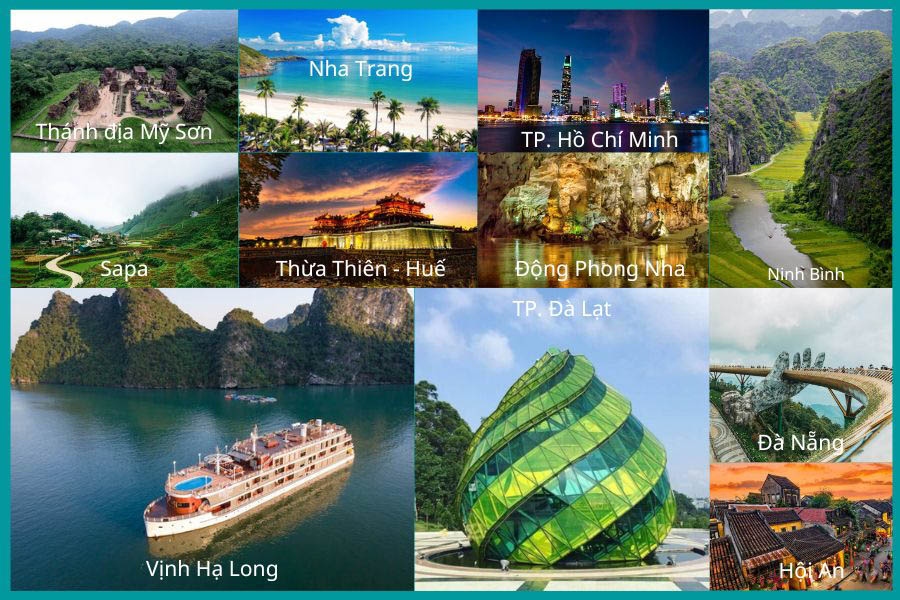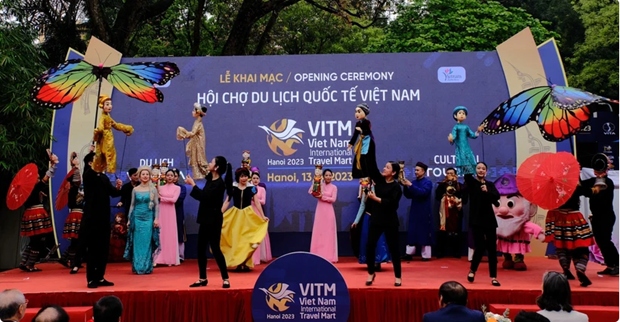Terrain, climate, weather and landscape of Da Lat make the city different.
The topography of Da Lat is divided into two distinct types: mountain topography and mountain plain terrain. The mountainous terrain is distributed around the central highlands of the city. The mountain ranges about 1,700 meters high form a windbreak belt covering the central basin. From the city looking to the north, Lang Biang is like a wall in the northeast - southwest direction, extending from Da Sar stream to Dankia lake. The two highest peaks of this mountain are Ong mountain with an altitude of 2,167 meters and Ba mountain with an altitude of 2,064 meters. To the east of Da Lat is the Bi Doup range with an altitude of 2300 meters and the Southeast is blocked by the Cho Proline range of 1,629 meters. The South and Southwest are surrounded by Voi mountain with an altitude of 1,754 meters and surrounded by Yang Soreng. To the south, the mountainous terrain transitions to a lower terrain, especially the Prenn pass area with high mountain ranges interspersed with deep valleys. The center of Da Lat is like an oval basin along the north-south direction with a length of about 18 km and a width of about 12 km. The hills here have a relatively uniform height, the slopes are gentle towards Xuan Huong Lake and gradually rise towards the surrounding mountains. The highest place in the city center is Nguyen Huu Hao Palace in Lam Dong Museum with an altitude of 1,532 meters, and the lowest point is Nguyen Tri Phuong valley, at an altitude of 1,398 meters.

In the area of Da Lat city, between the low hills of the city center and the surrounding mountains, more than 20 streams with a length of over 4 km can be seen, belonging to the Cam Ly, Da Tam and Da Nhim river systems. These streams are all upstream in the Dong Nai river basin. Cam Ly stream is 64.1 km long, originates from Lang Biang (Lac Duong district), flows in the North - South direction and pours into Xuan Huong Lake; This is the largest stream system in Da Lat, playing an important role in creating the landscape for the central urban area. Da Lat is also famous as the city of lakes and waterfalls with about 16 large and small lakes scatteredly distributed, most of which are man-made lakes. Xuan Huong Lake is located in the city center, about 25 hectares wide, built in 1919 during the construction of Da Lat. Xuan Huong Lake is located in the city center, is one of the symbols of Da Lat, also the heart of the city, and a national scenic spot.
Since it is located at an altitude of 1,500 meters and surrounded by mountain ranges and forest flora, especially pine forests, it contrasts with the tropical monsoon climate of Central Vietnam and the tropical savanna climate in Vietnam in the South, Da Lat city has a mild mountainous climate, cool all year round, this is one of the differences, and even more different thanks to the fact that the city is less vulnerable to global climate change. .
Located in the tropical savanna climate, Da Lat has two distinct seasons: the rainy season and the dry season. The rainy season starts from April and ends in October. The dry season lasts from November of the previous year to March of the following year. In the dry season, Da Lat is influenced by the air mass of the East Sea, bringing warm sunny weather, few clouds, no rain, the temperature drops at night and the temperature range is large. During the rainy season months, the northeast monsoon almost no longer affects Da Lat, replaced by the equatorial air mass from the south to the north. The southwest monsoon brings moisture mainly through heavy downpours and multi-day rains. However, due to the influence of the tropical Pacific air mass, there are still periods of dry weather during the rainy season.
The average monthly temperature in Da Lat is always below 18.3°C, even in the hottest months. During the winter months, the monthly average temperature is still above 15°C. According to statistics from 1998 to 2018, the average annual temperature in Da Lat is 18.3°C. In December, at the end of the year, the temperature at night drops down at about 6°C to 8°C, extremely cold. In winter, Da Lat morning has drizzling rain and it rarely gets sunny. The temperature range of day and night in Da Lat is very large, the annual average reaches 11°C, the highest in the dry season months, up to 13-14°C and the lowest in the rainy season months, only about 6-7°C. Total radiation yield in Da Lat is about 140 kCalo/cm²/year, the most in April and the least in August. Compared with neighboring areas, the amount of solar radiation in Da Lat is not high, but this is the main source of energy for heat exchange processes, bringing low and relatively mild temperatures.
The rainy season in Da Lat usually starts at the end of April, the beginning of May and ends around the end of October and the beginning of November. Although every year, the start and end of the rainy season can change, but the season Rain here usually lasts for more than 6 months. If averaged from May to October, the total rainfall in the rainy season in Da Lat accounts for nearly 80% of the annual rainfall. In Da Lat, there is another remarkable weather phenomenon, fog, which averages 80 to 85 days in a year, but occurs most in the period from February to May and from September to October. The most common type of radiation fog is formed when the ground is cooled by radiation at a clear, windless day; April is the month with the most foggy days of the year, Da Lat fog is considered as an attractive difference for tourists, also, cloudy fog in Da Lat is also a very interesting natural phenomenon attracting tourists to come to Da Lat.
The park has a total natural area of 64,800 ha, forest land area is 59,034 ha, of which nearly 50,000 ha of natural forest has not been affected yet. Bidoup - Nui Ba National Park has all the conditions to become a biological corridor for the development of plant and animal species from low to medium mountains. Bidoup - Nui Ba National Park, the core area of the Langbiang World Biosphere Reserve, is a standard sample of Vietnam's subtropical humid evergreen closed forest ecosystem and is also a typical forest type for the highland region, become one of the places of scientific research, cooperation on nature conservation and an eco-tourism destination associated with the characteristics of the indigenous culture known at home and abroad.
Da Lat - Heaven of Heaven
Da Lat is a magical city because of its mild climate, poetic natural landscape that always captivates people when they first arrive, makes them want to explore, and becomes unforgettable in their hearts. There is a city that looks beautiful wherever you go, for joy, love and health for everyone; The city where the space is always beautiful, captivates many talented artists to create many works or move people's hearts. Many films in which the director thinks creatively to have the most beautiful scenery create the core value of the film, but inadvertently make the audience watch the scenery of Da Lat more than the core of the film, Da Lat has done so many things. Back of thousands of passionate photographers, taking a lot of pictures but still wandering, Da Lat is one of the three cities in Vietnam with the most songs because of the love of professional and amateur musicians for Da Lat. Da Lat's natural resources and landscape architecture are also considered a valuable reward of parents for their loving children to visit or travel when they are good at studying or when their work is successful.
Is there any city that has created more tourists to think and discover more before putting their foot to Da Lat just because there are so many mysteries? Da Lat is a city that converges all residents of all parts of the country in the process of formation and development, thereby creating a unique style of Da Lat people: gentle, elegant, hospitable. Is there any city in Asia that is like Paris in Europe full of charm, making people flutter in their hearts when they first arrive? Da Lat has National Highway 27c which is the connecting road between flowers and the sea passing through old forests, blending in clouds and dew creating a very unique feature by the most beautiful natural heritage road in Vietnam; With what nature has bestowed, it has helped make Da Lat the city of paradise: tourism, love and agriculture.
Da Lat is like a dreamland
Each geographical location on this earth is a random formation of natural phenomena during the formation of the earth in the universe; But perhaps as a natural phenomenon that is about to happen to Da Lat city, the process of earth formation has given Da Lat a different height in Indochina, with topography, climate, landscape and biodiversity right in the tropics, so it has a very unique national and international character. Nature has endowed this place with extremely precious treasures that are hard to match anywhere else, such as an interesting nature; for a cool and fresh climate like living in the middle of a deep forest; for the wonderful landscape, poetic beauty, unexpected beauty everywhere; for many lakes with poetic landscapes to make the soul turn to the best, for many lyrical waterfalls, to make people's hearts like being held and from there to release the soul gently and creatively. All the bright and colors of the wonderful nature have touched people's hearts, because Da Lat is the land of human love.
Da Lat has majestic mountains and forests that make people close to nature, for many looming terrains, want to see without blinking; for the peaceful land to supply natural water from upstream to mix with the air; for fresh air to help people stay healthy all year round; for the poetic landscape to keep people from far away. The fertile soil and the unique climate have created a favorable environment for beautiful flowers, fresh vegetables and sweet fruits, making many people dream of natural products in this land.
 Continue to promote the core values of nature, architectural heritage and humanities of Da Lat in the context of climate change and international integration.
Continue to promote the core values of nature, architectural heritage and humanities of Da Lat in the context of climate change and international integration.
Da Lat has been implementing Decision No. 704/QD-TTg dated May 12, 2014 of the Prime Minister for Da Lat and surrounding areas until 2030, with a vision to 2050 of building and developing Da Lat city and its vicinity by 2030 into a modern, world-class urban area... After more than 7 years of implementation, Da Lat city and its vicinity gradually formed as a oriented city, the technical infrastructure connecting the inner and outer regions is gradually invested, contributing to the local socio-economic development, promoting the urbanization process, creating a driving force for the next stage of development; Together with the results achieved during the implementation of Decision No. 704/QD-TTg, there are still certain shortcomings and limitations and have not met the current conditions such as: The population forecast of Da Lat city has been determined. The calculation based on the rate of population increase naturally and mechanically is no longer suitable with the current situation of population development in the locality, imbalance between population and land use planning. The organization of urban space, the orientation of urban landscape architecture management criteria is not close to reality and is not suitable with the topography in the area, determining the land use purpose is still inadequate, causing difficulties in state management; The transport system connecting the satellite towns of Da Lat city with the historical central urban area is not adequate and appropriate, especially the impacts of climate change, global pandemic and inter-connected infrastructure have not been forecast. In the face of practical inadequacies, Lam Dong Provincial People's Committee has submitted a report to the Prime Minister and has been approved by the Prime Minister in Document No. 6364/VPCP-CN dated September 11, 2021 After the urgent time to implement the adjustment contents under the direction of the Prime Minister, the Provincial People's Committee has submitted a report No. 2120/TTr-UBND dated March 31, 2022 to the Ministry of Construction to appraise the task of adjusting regulations. plan according to 704/QD-TTg. Implementation of the Invitation No. 1158/BXD-QHKT on holding a meeting of the Council to appraise the overall adjustment of the general planning of Da Lat city and its vicinity to 2030, with a vision to 2045, Lam Dong defended the adjusted content of the planning project on the afternoon of August 23, 2022, which was approved by the National Planning Appraisal Council and submitted to the Prime Minister according to regulations.
The development process of Da Lat has been and will attract investment to form high-class commercial centers, develop unique cultural industries, smart financial centers, develop science and technology projects. technology, education and training. This is an opportunity for Da Lat city to expand its high-quality service activities, meet the requirements of international integration, and is a good environment for Da Lat to attract high-quality human resources in the future.
With the practical requirements of both urban development and preservation of architectural heritage, it is a very demanding requirement in the development process of Da Lat and its vicinity in the future. In parallel with the urban center, linking green urban villages with their own roles and functions will support and share the pressure on urban development of the city and create new linkages in the planning area. On the basis of area size, value of forest resources, high biodiversity, reasonable population density, good management and protection of environmental resources, promoting landscape architecture and humanity, present with the modernization of information technology, we can believe that it is a favorable condition for Da Lat city and its vicinity to have the opportunity to develop into a landscape city, a smart city, with a unique structure, aheritage city and creative city of the future. Economic development follows the trend of green growth, gradually develops a knowledge-based economy at a fast pace in the coming decades.
Pham S - Vice Chairman of Lam Dong Provincial People's Committee



